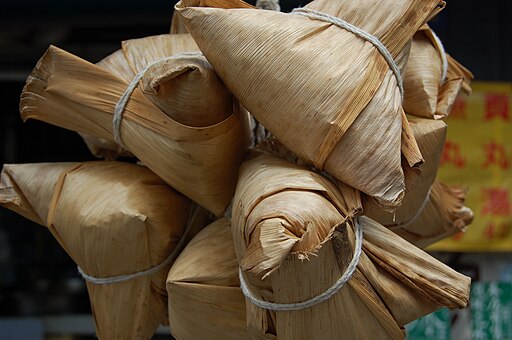Exploring the Culinary Traditions of the Dragon Boat Festival
The Dragon Boat Festival is an important cultural celebration in the Taiwanese world, rich in traditional customs and significance. Besides the renowned dragon boat races and hanging calamus plants, indulging in zongzi (sticky rice dumplings wrapped in bamboo leaves, 粽子) is an indispensable experience. Zongzi is not just a delicious festive delicacy but also embodies the meanings of the seasonal changes and cultural heritage. Let’s explore the diverse facets of Taiwan’s zongzi culture!
The Legendary Origins of Zongzi
There are many different legends about the origins of eating zongzi during the Dragon Boat Festival. The most well-known story commemorates Qu Yuan, a poet from the Warring States period. It is said that after being exiled, the despondent Qu Yuan committed suicide by drowning himself in a river. The people of Chu threw bamboo leaf-wrapped rice dumplings into the river to feed the fish, hoping they would not devour Qu Yuan’s body. These rice dumplings wrapped in bamboo leaves are what we now call zongzi.
Another tale relates zongzi to agricultural culture. Ancient people believed that eating zongzi could ward off plagues and was considered a way to pray for blessings. During the Dragon Boat Festival season, farmers would make zongzi to pray for a bountiful harvest and family safety. Whichever legend is true, zongzi has become an important cultural symbol representing unity, health, and auspiciousness during the Dragon Boat Festival.
The Regional Flavors of Taiwanese Zongzi: “Southern Boil, Northern Steam”
Taiwanese zongzi are rich in regional characteristics, with distinct flavors between the north and south. The most obvious distinction lies in the saying “southern boil, northern steam.” Southern-style zongzi involves boiling the raw sticky rice and fillings together wrapped in bamboo leaves. Northern-style zongzi, on the other hand, involves first stir-frying or steaming the sticky rice before wrapping it with fillings and then steaming the entire package.
Southern-Style Zongzi (南部粽)
- Cooking Method: Soak raw sticky rice, then wrap it together with pre-processed fillings like pork and mushrooms in bamboo leaves, and boil until cooked.
- Texture: Southern zongzi have a soft, glutinous, and chewy texture. The flavors are relatively light, often accompanied by sauces or peanut powder for added taste.
Northern-Style Zongzi (北部粽)
- Cooking Method: First, stir-fry or steam the sticky rice until partially cooked, then wrap it with fillings in bamboo leaves and steam the package.
- Texture: Northern zongzi have distinct, chewy, and separate rice grains, resembling fried rice and absorbing the aroma of the bamboo leaves.
Besides the north-south differences, Taiwan’s zongzi culture is incredibly diverse, with unique flavors originating from various ethnic groups and regions:
- Alkaline Zongzi (鹼粽): Also known as “ice zongzi,” made with round sticky rice soaked in an alkaline solution, offering a refreshingly sweet and chewy texture – perfect for beating the summer heat.
- Hakka Zongzi (客家粽): Made with sticky rice flour instead of grains, filled with ingredients like dried shrimp and mushrooms, without distinct rice grains visible.
- Savory Zongzi (鹹粽): Featuring pork as the main filling, such as the Huzhou fresh meat zongzi and five-grain meat zongzi, with rich flavors.
- Sweet Zongzi (甜粽): Filled with traditional sweet pastes like red bean or black sesame, such as the Huzhou red bean paste zongzi and nostalgic red bean zongzi.
- Vegetarian Zongzi (素粽): With the rising popularity of vegetarian diets, the fillings now often feature mushrooms, lotus seeds, and other plant-based ingredients instead of meat.
As you can see, Taiwan’s zongzi flavors are as diverse as they are numerous, catering to all tastes, whether you’re from the north or south, or adhere to different dietary preferences. Savoring the various zongzi is like embarking on a culinary journey through the island’s cultural heritage, allowing you to experience the unique charm of the Dragon Boat Festival.

The Art of Enjoying Zongzi
Eating zongzi is an art in itself! Start by peeling off the outer bamboo leaf wrapping, which is easier when it’s crispy. Then, gently open the zongzi from one end and slowly scoop out the filling, bit by bit, to avoid making a mess. Some zongzi are best enjoyed with a dipping sauce, like sweet and sour sauce, satay sauce, or chili sauce, adding a burst of flavors.
It’s important to note that zongzi are not exclusively for the Dragon Boat Festival day; in fact, fresh zongzi are available year-round in Taiwan! Whether you prefer the refreshing coolness of a chilled zongzi in summer or the comforting warmth of a hot zongzi in winter, there’s no wrong time to indulge. Many Taiwanese even treat zongzi as a convenient lunchbox option or a delightful picnic food to share with family and friends.
No matter where you are in the world, savoring Taiwan’s unique zongzi culinary culture is sure to provide you with a novel taste experience and cultural insight. In Taiwan, eating zongzi is not just a way to celebrate traditional festivals but also a language of connection and sharing between people. So let’s embrace our cravings and heartily enjoy these flavorful dumplings, brimming with the warmth of human connections!
